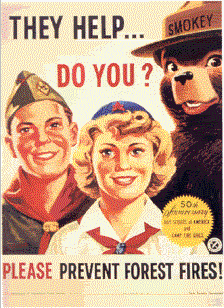| The requirements to this merit badge are copyrighted by the Boy Scouts of America. They are reproduced in part here under fair use as a resource for Scouts and Scouters to use in the earning and teaching of merit badges. The requirements published by the Boy Scouts of America should always be used over the list here. If in doubt about the accuracy of a requirement, consult your Merit Badge Counselor. |
|---|
| Reading this page does not satisfy any requirement for any merit badge. Per National regulations, the only person who may sign off on requirements is a Merit Badge Counselor, duly registered and authorized by the local Council. To obtain a list of registered Merit Badge Counselors, or to begin a Merit Badge, please contact your Scoutmaster or Council Service Center. |

Requirement 1
editDo the following:
- A. Demonstrate the technique of stop, drop, roll, and cool. Explain how burn injuries can be prevented.
- B. List the most frequent causes of burn injuries.
Requirement 2
editExplain the chemistry and physics of fire. Name the parts of the fire tetrahedron. Explain why vapors are important to the burning process. Name the products of combustion. Give an example of how fire grows and what happens.
Requirement 3
editName the most frequent causes of fire in the home and give examples of ways they can be prevented. Include a discussion about fires caused by smoking in the home, cooking, candles, fireplaces, and electrical appliances.
Requirement 4
editDo the following:
- A. Explain the role of human behavior in the arson problem in this country
- B. List the actions that cause seasonal fires and explain how these fires can be prevented.
Requirement 5
editList common circumstances that cause holiday-related fires and explain how these fires can be prevented.
Requirement 6
editConduct a home safety survey with the help of an adult. Then do the following:
- A. Draw a home fire-escape plan, create a home fire-drill schedule, and conduct a home fire drill.
- B. Test a smoke alarm and demonstrate regular maintenance of a smoke alarm.
- C. Explain what to do when you smell gas and when you smell smoke.
- D. Explain how you would report a fire alarm.
- E. Explain what fire safety equipment can be found in public buildings.
- F. Explain who should use fire extinguishers and when these devices can be used.
- G. Explain how to extinguish a grease pan fire.
- H. Explain what fire safety precautions you should take when you are in a public building.
Requirement 7
editDo the following:
- A. Demonstrate lighting a match safely.
- B. Demonstrate the safe way to start a charcoal fire.
- C. Demonstrate how to safely light a candle. Discuss with your counselor how to safely use candles.
Requirement 8
editExplain the difference between combustible and noncombustible liquids and between combustible and noncombustible fabrics.
Requirement 9
editDo the following:
- A. Demonstrate the safe way to fuel a lawnmower.
- B. Demonstrate the safety factors, such as proper ventilation, for auxiliary heating devices and the proper way to fuel those devices.
Requirement 10
editDo the following:
- A. Explain the cost of outdoor and wildland fires and how to prevent them.
- B. Demonstrate setting up and putting out a cooking fire.
- C. Demonstrate using a camp stove and lantern.
- D. Explain how to set up a campsite safe from fire.
Requirement 11
editVisit a fire station. Identify the types of fire trucks. Find out about the fire prevention activities in your community.
Requirement 12
editChoose a fire safety-related career that interests you and describe the level of education required and responsibilities of a person in that position. Tell why this position interests you.
External links
edit- Fire Safety Merit Badge with Workbook PDF, current requirements, and resources.
| Earning Merit Badges in the Boy Scouts of America |
|---|
| Safety |
| Emergency Preparedness | Fire Safety | First Aid | Lifesaving | Safety |